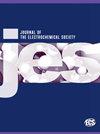分析采用易燃性降低电解质电池的锂离子电池模块中的热失控现象
IF 3.3
4区 工程技术
Q2 ELECTROCHEMISTRY
引用次数: 0
摘要
我们对热失控传播进行了全面分析,重点关注模块和电池两个层面,使用了一系列标准易燃性和低易燃性电解质,电池为 Eagle-Picher Technologies 公司生产的 18650 电池。利用加速速率量热法等技术,对电池焓、最大热失控温度、热失控起始温度和启动温度进行了评估,并一致证明了其可靠性。采用 NASA X-57 模块坯料作为缓解热失控传播的策略,观察到在失效事件中电池能量的吸收,有效地防止了热失控在电池之间的传播。值得注意的是,使用易燃性降低的电解液后,模块级的最高热失控温度平均降低了 104 °C,从而降低了在故障期间防止热失控传播的风险。请注意,在单个电池测试中,可燃性降低的电池与标准可燃性电池之间的差异相对较小,仅为 51 °C。这强调了在开发认证系统时在电池和模块两个层面进行测试的重要性,电池层面的数据显示出 51 °C的差异,而模块层面的分析则显示出更大的104 °C差异。本文章由计算机程序翻译,如有差异,请以英文原文为准。
Analyzing Thermal Runaway Propagation in Lithium-Ion Battery Modules with Reduced Flammability Electrolyte Cells
A thorough analysis of thermal runaway propagation was conducted, focusing on both module and cell levels, using a range of standard flammability and reduced flammability electrolytes in 18650 cells sourced from Eagle-Picher Technologies. Utilizing techniques such as accelerated rate calorimetry; cell enthalpy, maximum thermal runaway temperature, and thermal runaway onset and initiation temperatures were evaluated, consistently demonstrating their reliability. Employing the NASA X-57 module billet as a strategy for mitigating thermal runaway propagation, the absorption of cell energy during failure events was observed, effectively preventing the spread of thermal runaway between cells. Notably, the use of reduced flammability electrolyte resulted in an average reduction of 104 °C in maximum thermal runaway temperature at the module level, thereby offering decreased risk in preventing thermal runaway propagation during failures. Note the relatively modest 51 °C difference observed between reduced flammability and standard flammability cells during individual cell tests. This underscores the importance of conducting tests at both the cell and module levels in the development of systems for certification, where the cell-level data indicate a 51 °C discrepancy, while the module-level analysis shows a more substantial 104 °C differentiation.
求助全文
通过发布文献求助,成功后即可免费获取论文全文。
去求助
来源期刊
CiteScore
7.20
自引率
12.80%
发文量
1369
审稿时长
1.5 months
期刊介绍:
The Journal of The Electrochemical Society (JES) is the leader in the field of solid-state and electrochemical science and technology. This peer-reviewed journal publishes an average of 450 pages of 70 articles each month. Articles are posted online, with a monthly paper edition following electronic publication. The ECS membership benefits package includes access to the electronic edition of this journal.

 求助内容:
求助内容: 应助结果提醒方式:
应助结果提醒方式:


